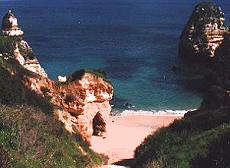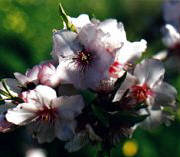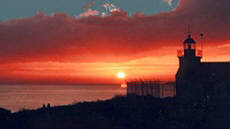The Algarve at a Glance

Secluded Camilo beach near Lagos.
![]()
The Algarve, Portugal’s southernmost province, occupies about one-fifth of the country’s area. Since it’s where most vacationers go in search of warmth, relaxation and golf, that’s where this series will begin.
Stone Age burial grounds show that the Algarve has been inhabited for thousands of years. There have been many invaders and rulers over the centuries, among them Romans, Moors and Spaniards. All have left their mark, such as forts and protective walls, the vestiges of numerous battles. During the 60 years that Spain controlled the country, there were raids by Sir Francis Drake and others, who destroyed a number of important sites. Later, many towns were badly damaged by the earthquake of 1755, which was so powerful that it was felt as far away as Sweden. For the past 360 years, though, the Algarve has been the peaceful home of farmers and fishermen.
Because of its fertile land and temperate climate the Moors considered it their “garden” for some 500 years. Here you’ll find all the flowers, plants and trees that grow around the Mediterranean, as well as one unique feature – gazillions of almond trees.

The almond trees of winter.
![]()
Legend has it that a Moorish ruler’s daughter was homesick for the snow that she used to see on the Atlas Mountains where she grew up, so her father had thousands of almond trees imported to ensure that her new homeland would always be blanketed in white in the winter. Today the entire province is a sea of white and pale pink for three weeks in January and February, and great pastries and confectionery bear sweet witness to Portugal’s love affair with almonds.
The roughly 200 km (120 miles) of coastline boast an almost continuous string of golden sandy beaches, many sheltered by sandstone formations of varying shapes and colours. Golf lovers will revel in its two dozen courses, some of championship calibre, and relatively inexpensive. Inland, its northern boundary is marked by hills, the tallest of which reaches 900 m (3000 ft).
The administrative headquarters, largest city, and site of the international airport is Faro (perhaps 50,000), about a quarter of the way west of the Spanish border. In the centre of the coast is Albufeira, a chic resort especially popular with British visitors. Farther west is the second largest city, Portimao, a fishing port with a booming tourist centre at suburban Praia da Rocha. Farther west again is my favorite historic town, Lagos, north of which is the former Moorish capital of Silves, notable for its fort. At the western extremity is Sagres, which was known to sailors for centuries as “the end of the world, beyond which lie sea serpents and…”
Each of these places has a fascinating character, which will be highlighted in subsequent articles. There is still plenty of unspoiled space east of Faro and west of Lagos, but the earlier charm of its central towns has given way lately to an excess of new hotels and apartments, some too ultra-modern for my taste. You’ll find a whole lot more information of all kinds at www.algarve-holiday.co.uk.
When my wife and I first visited in 1986, there was a fair two-lane highway south from Lisbon to the centre of the province, but the main east-west route to which it connected, EN125, was in bad shape. Because of all the potholes it once took us over two hours to drive about 50 km (30 miles) from Lagos to Sagres. (You’ll learn why we went in a later article). Now the entire EN125 has been repaired, and a new four-lane highway runs parallel to it from a beautiful bridge at the Spanish border as far as Albufeira, with an eventual extension to go past Portimao.

Sunset at Ferragudo.
![]()
During our three visits we’ve found that the climate can vary considerably. We’ve been told that the winter norm is six days of sunshine and one overcast or rainy day per week. That’s exactly what we experienced in 1986, but the winter of 1991-92 was the driest in memory, warm and sunny with only five days of rain in 10 weeks. No complaints there! At the opposite extreme, in 1996 we had three weeks of sunshine and three weeks when we might as well have been in Seattle. But at least we didn’t have to shovel it!
The Algarve is one of the great bargain destinations of our time, particularly if you stay in a three- or four-star apartment hotel or condo and make most of your own meals, as we did. (See your travel agent). We once met a retired USAF general who was back with his wife for their tenth holiday.
Here are some examples in US dollars:
You can get round-trip air from eastern North America (e.g. Montreal) and an apartment with maid service for a month for about $1,000 per person double.
Car rentals are probably the lowest in Europe (c. $120 per week), although gasoline costs about $5 per gallon.
Top-quality local produce and fresh-caught fish are inexpensive, and always available.
Table wine costs about $1 a litre, and a bottle of good rosé is half the price we’re used to paying.
You can buy big juicy oranges freshly picked off the trees for about 60 cents a dozen.
If you’ve been spoiled by Tim Horton’s or Starbucks, you’ll be happy to hear that Portugal is one place in Europe where you can buy good coffee. There are well-stocked supermarkets, but many things that we take for granted such as canned or frozen foods are prohibitively expensive. You’re bound to enjoy the wide variety of copper, pottery and ceramics with colours and designs specific to each town or village.
Articles about individual destinations are coming soon…
Questions?
If you want more information about this area you can email the author or check out our Europe Insiders page.